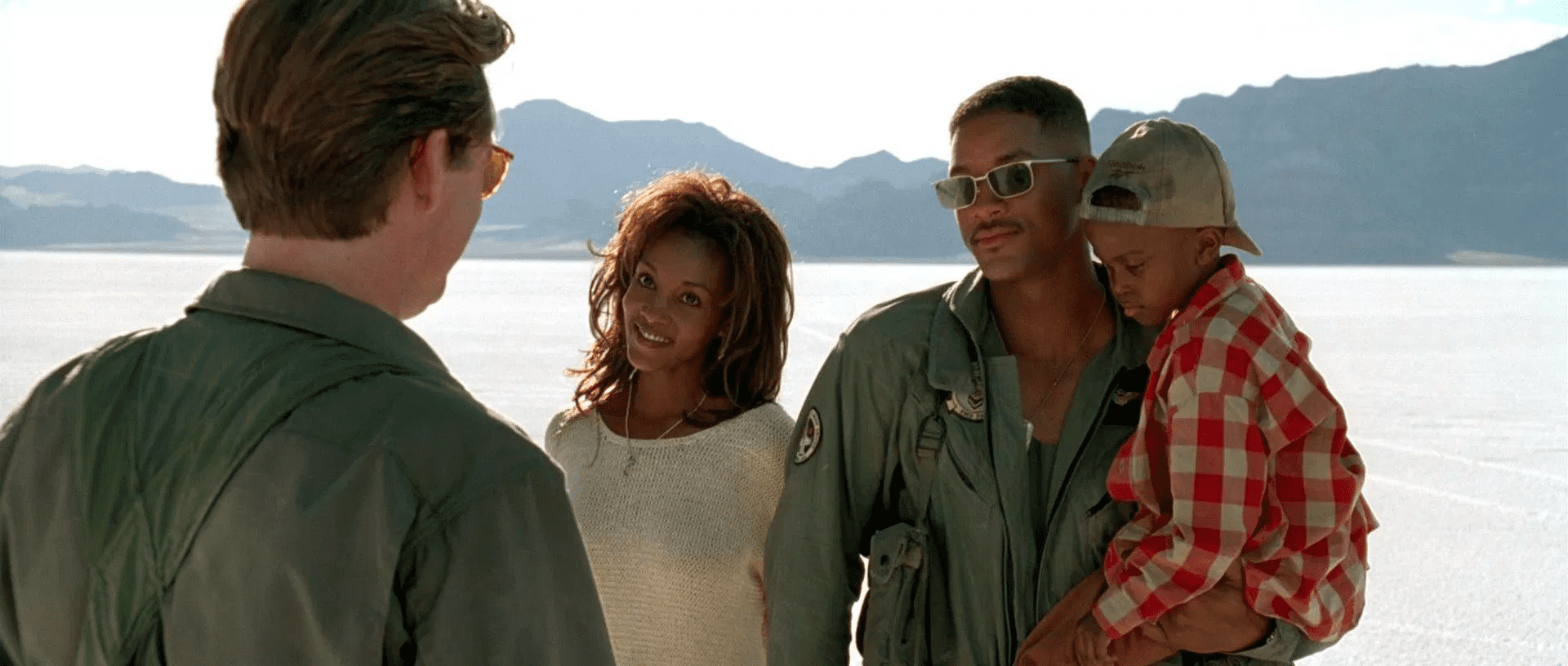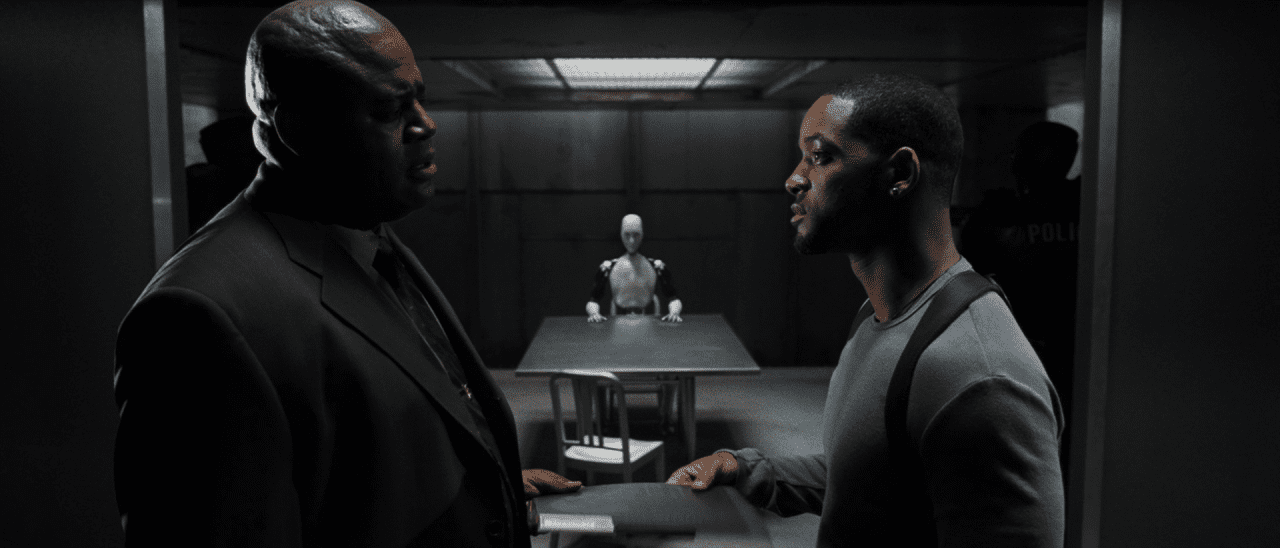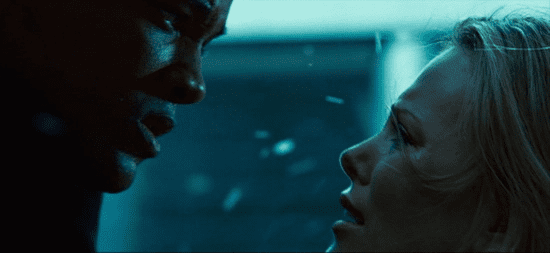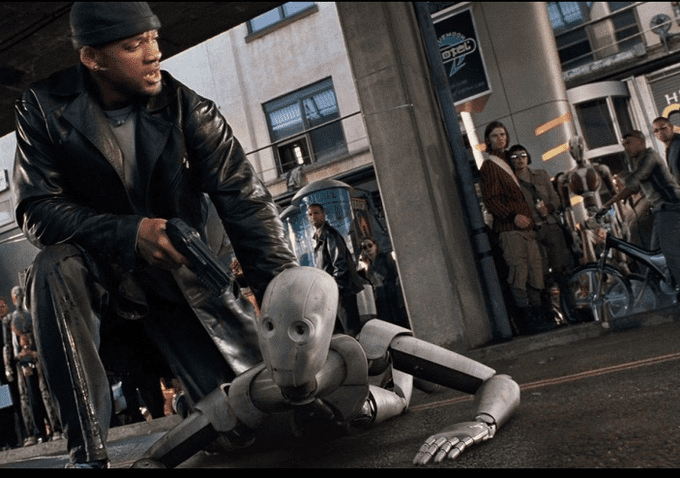
Given that America is constantly looking over its shoulder for the enemy at home, it is culturally comforting in the nervous America of today for people – who have a very vocal and at times militant history of chastising and challenging white America – to lead the charge to defend America from attack in a sci-fi future […] to affirm the belief that patriotic solidarity transcends racial loyalty, even if only in American pop culture.
–Adilifu Nama, Black Space
Floating screens: black bodies, unfathomable, violent acts. Only Will Smith has been spared.
–Dawn Lundy Martin, Life in a Box is a Pretty Life
The bass-laden trailer for yet another nostalgia sequel preluded my recent second viewing of Star Wars: The Force Awakens. 20th Century Fox will release Roland Emmerich’s Independence Day: Resurgence this summer, twenty years after its predecessor helped to launch Will Smith to blockbuster movie stardom. But while the trailer promises more of the same—metropolis-sized alien warships, battle-worn humans gazing skyward in terror, assault weapons and jingoism by the mouthful—what’s noticeably missing is, in fact, Will Smith in his central role as Captain Steven Hiller.
Jeff Goldblum returns to play the quirky techno-savant David Levinson; Bill Pullman, in bearded semblance of Ulysses S. Grant, reprises the role of (now ex-?) President Whitmore, whose original, unsubtly post-race morale speech echoes loudly throughout the last half of the trailer; even Vivica A. Fox’s Jasmine Dubrow appears briefly in what is likely a cameo within a cameo. Smith, who elected not to return for the sequel, revealed in an interview that Jasmine’s spouse, Capt. Hiller, is dead. According to the film’s official website, he died “while test piloting the ESD’s first alien hybrid fighter.” Fans of the first Independence Day (1996) will have to contend with Smith’s absence from the franchise that introduced him as a viable lead in science-fiction action-adventure, but lately I’ve been enthralled with the question: What has been done with his presence in that genre? Smith has placed black protagonists into uncharted regions of space, time, and technology, but to whose benefit?
The spoilers rear their heads in Independence Day. A humongous alien mothership approaches Earth and dispatches three dozen smaller ships—each about “fifteen miles wide”—into the atmosphere where they hover ominously over the usual Western cities before spectacularly destroying symbolic structures such the US Bank Tower, the Empire State Building, and the White House. As the thin plot unfolds, their objectives are clear: invade the planet, exterminate the inhabitants, and deplete the resources. As Noah Berlatsky reminds us in his essay “Why Sci-Fi Keeps Imagining the Subjugation of White People,” most of the imaginative work for popular alien invasion narratives has been done by European colonialism historically, and Independence Day’s co-writer and director Roland Emmerich distills it into a few basic bullet points with an assertively Western-white-centered perspective on events.
All that keeps Independence Day from being Armageddon (1998) with aliens are the central presences of Smith and Fox, who respectively portray a fighter pilot in the US Marine Corps and an exotic dancer and mother. Capt. Hiller, Jasmine, and Jasmine’s son Dylan (Ross Bagley) compose a black family whose survival becomes integral to the plot, adjacent to the white family comprised of Pullman’s President Whitmore, the First Lady, and their daughter. The centrality of black characters is essential to reinforce the film’s aim at depicting a united (American) human race while attempting to “use an alien enemy to make racial strife obsolete,” as Adilifu Nama observes in the compelling critical volume Black Space: Imagining Race in Science Fiction Film. Further such mirroring occurs in the occupations of Hiller and Whitmore; both are combat pilots, Whitmore a Gulf War veteran whose election campaign revolved around his war-hero status. But it’s Hiller’s military service that, I think, sets the tone for the pop sci-fi phenomenon that Will Smith has become.
Asserting military duty is one way that white-ascendant empire attempts to erase the race-, sex-, and class-based atrocities committed within national borders by shifting the burden of otherness—creating “the enemy” at the state’s most remote fronts. For those who, at home, are systematically oppressed, antagonized, and unprivileged, this effects a dilemma of citizenship, the kind of double agency referenced by Judith/Jack Halberstam in the 2010 lecture “The Killer in Me is the Killer in You: Homosexuality & Fascism” with regard to the complicity of gay German men in the Nazi party. Citizenship demands that we reject and / or violate categories of our personal identities for the sake of national identity, depending on our immediate position in the present power relationship. This is why I was so shifty when I attended my brother’s graduation into the United States Army Reserves. This is why 9/11 was a pivotal moment in the gay rights movement. It matters that Hiller is already a charismatic marine when the aliens arrive. It matters that Smith’s roles in sci-fi films largely consist of state agents: Civil War hero, detective, military virologist, celebrated general, ex-NYPD turned alien surveillance operative. And here’s one basic reason why: these films are received messages of potential progress for the large movie-watching population of a society that allowed itself to believe it was “post-racial.” Smith’s characters act as witnesses for the rehabilitated offender, the white-supremacist nation-state.
It also matters that Independence Day is one of the last sci-fi films in which Smith has a black love interest who survives the narrative. As the genre is notorious for fantasizing the desires and anxieties of contemporary American race relations, particularly in its affirmation of color-blind idealism (Nama notes this throughout Black Space), the depictions of amorous and erotic partnerships are important as oft-overlooked or trifled sites of racial dialogue. My inquiry of my own long list of white ex-boyfriends has helped me to understand, often painfully, that sexual desire and partnering practices are neither immune to nor outside of state-based supremacist values. To echo Hari Ziyad, for an individual in a body politic, love—being engendered in a psyche that is subject to the consumerist impulses to which national media caters—is not as ecstatic as we have wanted to believe.
Black love, perhaps not in and of itself, becomes a radical act most immediately when precluded in dominant melting-pot narratives that manage to privilege partnerships involving at least one white person. Specifically, in the chaos and uncertainty of sci-fi futures, white partners represent the continuity of a historical center, and therefore they connote stability and civilization. Paradoxically, it is white-involved interracial relationships that get to be positioned as both revolutionary (because apparently overcoming history) and comforting (because whiteness is familiar and desirable). Such is the plight of Angela Bassett’s characters in Strange Days (1995) and Supernova (2000). In his expansive survey, Nama proposes that the prevalence of interracial relationships in apocalyptic and post-apocalyptic sci-fi films, including 1971’s The Omega Man (of which Smith’s I Am Legend is a remake), implies that only the collapse of race-obsessed Western civilization can adequately erode the color line for the tolerant futures these partnerships symbolize (66).
The alignment of Will Smith’s characters with state agendas—surveillance of the alien other and deportation of unsanctioned refugees in Men in Black (1997), suppression of disenfranchised uprising in I, Robot (2004), militarized frontierism in After-Earth (2013)—is coupled with curious partnership narratives: respectively, Agent Jay and a single white woman (Linda Fiorentino) survive victorious; Del Spooner and a single white woman (Bridget Moynahan) survive victorious; Cypher Raige’s black wife (Sophie Okonedo) is dead. It’s worth noting that the exaltation of the lone-gun bachelor is traceable in the sci-fi action-adventure back to its foundations in the American Western, a genre in which the state is an untrustworthy entity though its colonial desires are nonetheless reflected in subtexts of bootstrap individualism, triumphs over indigenous populations, and the white-ascendant boomtowns displacing them. Even Wild Wild West (1999), though initially attempting to position Smith’s Capt. James West as antiestablishment (mostly in order to affirm gadget-less, trigger-happy American hypermasculinity on the eve of Y2K), eventually valorizes his state-complicit heroism.
Contrary to its title, Tony Scott’s hyper-surveillance thriller Enemy of the State (1998) presents Smith at his most nonthreatening, portraying Robert Dean, a successful DC lawyer, father to Eric (Jascha Washington), and loyal husband to Carla (Regina King). The Deans even employ a Latina nanny. This deployment of the middle-class, nuclear family model not only validates Dean’s blackness by supplementing a normative kinship formation; it also foregrounds the sinister invasiveness of the film’s antagonist, the National Security Agency pre-9/11, which threatens the family’s wellbeing and presents a truer threat to neoconservative values—also conveyed in Dean’s astute knowledge of Constitutional rights—than black access to the American middle class.
Men in Black is interesting, too, in that while the eponymous agency seems to focus on heavily monitoring the immigrant alien population concealed within the multi-ethnic landscape of New York City, the film’s design, casting, and plot present a clear investment in the black-white binary and low-key flexes notions of black upward mobility. Smith’s Agent Jay leaves behind the baggy, sneakered hip-hop exterior of his previous identity as Officer James Edwards—characterization that, for argument’s sake, we can also locate in Mike Lowrey (Bad Boys, 1995) and The Fresh Prince of Bel-Air—to don a crisp suit, polished shoes, and (inferably) a larger salary. The transformation seems almost prophetically aware of Smith himself, who was “in West Philadelphia, born and raised”; whose acting career began at the center of one of TV’s most beloved black-casted sitcoms; and who would eventually abandon his rap career altogether in favor of high-profile roles and the respectability politics attached. I don’t think I can exaggerate the irony of Agent Jay’s climactic standoff with Men in Black’s antagonist—a gigantic roach from space—especially when it seems scripted as a racist joke and Jay’s dialogue rings of the Dozens. Assisting in the defeat of the Bug also marks Jay’s promotion to senior MIB status.
Jay’s flirtations with Fiorentino’s Dr. Laurel Weaver throughout the film invite a belabored—but not baseless—criticism of upwardly mobile, black heterosexual men: that they partner with white women. This criticism, when leveled, is often an indictment for a kind of racial amnesia, for an attempt to transcend what is seen as a black man’s place, and also for a failure to uplift the community signified by the kinship formation of two black partners.
Hancock (2008) appears to satirize this notion with apotheosis being the mode of exaggeration. Upward mobility gives way to literal godhood as Smith’s boozy, indestructible superhero John Hancock finds himself inexplicably attracted to Mary (Charlize Theron), his image consultant’s wife, who hurls Hancock through a wall after they nearly kiss. Mary then reveals to Hancock that they both are “Gods, angels. Different cultures call us by different names. Now all of a sudden it’s ‘superhero.’” Later, she tells him that they were created as a pair; that they gradually become more vulnerable, more mortal when they are together; and that each time they have reunited throughout history, they have been viciously attacked, with Hancock typically saving Mary and bearing the wounds. In these stories, whatever beings Hancock and Mary are seems superfluous as the reason they were attacked beyond having resembled a mortal interracial couple, particularly in 1850 and again in the 1930s, when Hancock and Mary were on their way to see Boris Karloff in Frankenstein (1931) and Hancock suffered the head trauma from which his amnesia results. That the two had intended to view a film depicting a large, living-dead monster who accidentally kills a girl and incites the blood-thirst of a lynch mob is a well-placed expositional detail.
In the end, Hancock has to leave town in order to save Mary and himself, and to preserve Mary’s white family. Before the drama of this partnership takes center-screen, however, Hancock generally tears around, apprehending criminals while spitting queer-antagonistic and misogynistic one-liners, costing the city millions of dollars in damage, and dodging court dates until the image consultant, Ray (Jason Bateman), persuades him to do jail time for the citizens’ catharsis and in order for his absence to prove him necessary. In prison, Hancock enters a population made up mostly of inmates whom he helped to incarcerate and who are, realistically, predominantly men of color. Hancock, while not a sci-fi film, falls in line with those that find Smith at the intersection of blackness and citizenship, performing in the service of the state—here, aggrandizing the prison industrial complex as if with no bird’s-eye knowledge of its growth and pervasiveness within, at least, the past eighty years.
More so than these films tend to require the willing suspension of disbelief, they petition audiences to digest them with highly selective socio-historical traction—even when their narratives collapse time. In I, Robot, when Detective Del Spooner chases a robot who dashes through crowds clutching a purse, I register that in Chicago, in the year 2035, a black cop is pursuing a member of an externally identifiable, servile population; that in the cop’s imagination this population is innately criminal; that when the cop tackles and pulls a gun on the robot—at the protest of its owner to whom it was delivering urgent asthma medication—his retort of “I saw a robot running with a purse; naturally, I assume…” parallels the kind of unchecked prejudice behind stop-and-frisk programs and real-world cases of police brutality. In the audio commentary, I, Robot’s screenwriter Akiva Goldsman says that he and director Alex Proyas wanted this scene, which culminates in comedy, to depict Spooner as “this side of irrational.” Backed by his gun, badge, training, and executive authority, Spooner’s prejudiced vigilantism is essential to the narrative’s rising action, and it has enough models in the tangible present to avoid falling on that side of irrational. When I, Robot is read as a vision of a possible future, however optimistically the film ends, it resonates as an indictment of the contemporary calls for police reform, specifically regarding failed conversations about lax attention to the psychological welfare of officers.
Clearly, some of these connoted layers of awareness are intended, but, as with most narratives that have only recreational investments in race, the layers proliferate meanings far beyond what the film can reconcile. Similarly to the presence of black lead Duane Jones in George Romero’s original Night of the Living Dead (1968), I, Robot capitalizes on the ability of Smith’s blackness, however “safe,” to enrich surface-level cultural critique by visually overlapping anxieties about racial uprising and sci-fi’s obsession with the ethical question of artificial intelligence and its achievement of sentience. The film’s climax then circumvents both concerns by deploying a class warfare allegory. Having the robots coded as an enslaved and sub-human population that then attempts to overthrow and subjugate the dominant class, the film pressures a satisfying resolution to the subplot of Spooner’s suspicion of and antagonism toward the benevolent robot Sonny, whom Sean Brayton describes in “The Post-White Imaginary in Alex Proyas’s ‘I, Robot’” as having “a pale white complexion and a ‘generic’ Midwestern dialect, stereotypical of white suburbia … a machine made quite literally in the image of a white man…” (74). Spooner’s subsequent warming-up to Sonny, while necessary to their uniting in a fight against an out-of-control and murderous operating system, displays the overreaching positivity that Nama observes in other sci-fi films such as They Live (1988) and Enemy Mine (1985), the latter of which, Nama writes, “settles for suggesting that American racial conflict and division are best resolved at the individual level and ceremonially applauded rather than collectively challenged and institutionally changed” (75).
Smith’s capacity as representative of the human race reaches its apex in I Am Legend (2007). He portrays the military virologist, Lt. Colonel Robert Neville, the sole survivor of a pandemic that killed ninety percent of the world’s population and mutated another nine percent into nocturnal, albino vampires. In “The Racial Politics of Disaster and Dystopia in I Am Legend,” Brayton notes that the film’s race politics are “slippery”: the last man on Earth is a black military officer and the rabid, conscienceless “dark seekers” he fights to evade are coded as white terrors, but, due to their dispossession and abject marginality, they “may also be a proxy for a predominantly black underclass stranded in New Orleans” after Hurricane Katrina in 2005 (72). Nonetheless, Neville’s commitment to remaining in what’s left of New York City—“ground zero”—to find a cure evinces his devotion to restoring state order. The accomplishment of his mission seems projected through the film’s theatrical ending, when, after Neville martyrs himself to save them from dark seekers, the woman-and-child pair of São Paolo migrants Anna (Alice Braga) and Ethan (Charlie Tahan) arrive at the gates of a survivor’s colony with a vial of Neville’s vaccinated blood and are greeted by armed guards and a picturesque Smalltown, USA, complete with church bells, an American flag, and a steeple in the distance. This ending, missing the opportunity for a more nuanced reconciliation to a film that largely decentered whiteness, was chosen after a test audience rejected the alternate ending in which the dark seekers’ attack is actually a mission to rescue the “alpha female” from being the latest in a long line of those fallen victim to Neville’s vaccination experiments. In the Director’s Cut ending, Neville lives and accompanies Anna and Ethan on their journey; with the destination not explicitly rendered, the audience is instead left with a vision of multiracial survival and potentiality.
The excision of this scene—and its implications of a sci-fi future neither centered by whiteness nor remanded by the nation-state—turns me toward The Matrix trilogy (1999–2003) and the fully realized black-revolutionary potential curtailed in its casting. Smith has first cited skepticism of the script and then immaturity as the reasons he turned down the lead role of Neo in The Matrix (1999); the latter reason begs the question of what histrionic demands the role (filled by Keanu Reeves) required that Smith could not have met by the time he led the all-star cast of Enemy of the State (1998). Moreover, Reeves’s portrayal of Neo fails to satisfy the critical race allegory the film introduces. Neo lives in white-dominated, late-capitalist America with a sense of being subject to omniscient, miasmic forms of abuse; his feeling of corrupt dissonance within the assigned reality is familiar most immediately in the paradox of black American identity, wherein access and achievement are, on the one hand, almost preternaturally deferred, and, on the other, contributory to institutions that perpetuate the conditions it was necessary to, through labor, transcend in the first place.
Although Nama reads Reeves’s “wooden, if not blank” performance as one that benefitted the films by allowing audiences to connect emotionally with their non-white characters (144), The Matrix trilogy’s narrative of human subjugation (people are literally grown in “endless fields,” used to generate electrical energy, and, like batteries, likewise disposed of) by a race of order-obsessed, sentient machines is unnecessarily muddled by the white-savior figure of Reeves’s Neo and his romance with Trinity (Carrie-Anne Moss)—a role for which Janet Jackson was originally approached. As Nama notes, even the costume design—Morpheus (Laurence Fishburne), Neo, and Trinity clad all in black leather and sunglasses—“invokes the political swagger and radical chic machismo of the Black Panther Party” (144). To have, in addition to the determinedly multiracial crew of the Nebuchadnezzar, a black trio of Neo, Trinity, and Morpheus spearheading the human resistance effort alongside the black leadership of Zion, the last human city—including Capt. Niobe (Jada Pinkett Smith), Commander Lock (Harry Lennix), Councilor West (Cornel West), and the Oracle (Gloria Foster/Mary Alice)—seems unimaginable and remains unrealized as a radical inversion of sci-fi’s white-centered dystopian futures. Amplified black centrality in The Matrix trilogy, far beyond anchoring its liberation narrative, would have enriched its discursive potential. For instance, the overwrought subplot of the rogue program Agent Smith’s (Hugo Weaving) attempts to possess Neo and copy himself infinitely signifies corporate vampirism and allegorizes the project of global white ascendance via cultural absorption—here, read through Reeves’s Native Hawaiian and Chinese ancestry. It also evades, in lieu of a black Neo, critiques of black cultural consumption by whites alongside the neocolonial enterprise of urban black displacement; internalized white supremacy under capitalism and the postcolonial indoctrination of marginalized groups; anxieties of race-mixing and racial purity; and, simply by contrast, the aggression and futility of white homogeneity.
The recent backlash against this year’s ubiquitously white Academy Awards nominations—with his partner Jada Pinkett Smith among those most vocal in favor of divesting from that institution—has found Will Smith funneling questions about Hollywood’s race politics and responding un-ironically in the vein of bootstrap-idealistic doctrine. In a January interview with Robin Roberts on Good Morning America, he was reluctant to situate himself autonomously within the conversation, resolving instead to boycott the Oscars out of matrimonial allegiance. While this resists male-centering the prominence of Jada’s dissident (though not unprecedented) call to action, Will Smith’s dilemma is presumable. After a marked decline in a career built on his cosigning ideologies of white neoliberalism and American-imperialist agendas, he may be no longer be inoculated against the perpetrated biases and violence of those institutions; to challenge them outright could be to risk future roles by overshadowing his a/political blockbuster persona, and to thereby risk being a once-prominent black actor deprived of a lucrative niche.
***
Works Cited
Brayton, Sean. “The Post-White Imaginary in Alex Proyas’s “I, Robot”.” Science Fiction Studies (SF-TH Inc) 35, no. 1 (March 2008): 7–87.
Brayton, Sean. “The Racial Politics of Disaster and Dystopia in I Am Legend.” The Velvet Light Trap, 2011: 66–76.
Martin, Dawn Lundy. Life in a Box is a Pretty Life. New York: Nightboat Books, 2015.
Nama, Adilifu. Black Space: Imagining Race in Science Fiction Film. Austin: University of Texas Press, 2008.
***
Image credits: Feature image, image 2, image 3, image 4, image 5.









